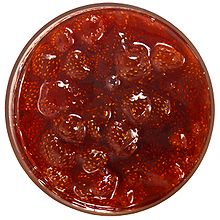Jam fruits
As Konfitfrüchte is known in sugar solution preserved or pickled fruits and fruit vegetables .
term
Konfit refers to the French term confire for preserving , which goes back to the Latin term conficere in the sense of to prepare, to prepare . This leads to an overlap in different cultures with similar uses such as jam for fruit spreads, confectionery for sweets or confit for meat.
preparation
In preparation, sugar is boiled with water. The result is called sugar solution , sugar syrup or sugar syrup or shortened syrup. The fresh fruits are cleaned, separated from inedible parts such as stems, blossoms and damaged areas and, depending on the recipe, roughly cut. Depending on the fruit, tradition and quality, the fruits are placed in the freshly prepared hot solution or boiled with it for a short time. They are then neither crushed nor mashed . After cooling and a short ripening phase for the sugar solution to be absorbed by the fruit tissue, the fruits are ready to eat. They differ from candied fruits in that they have a lower sugar content, and the uses for garnishing and decorating are the same. Some jams in weak sugar solution are also known as compotes .
Occasionally, roots such as beetroot , turnips and radishes are also prepared accordingly. Instead of sugar, honey is sometimes used for sweetening.
variants
Sladko / Slatko

Sladko , Serbian Slatko (from Bulgarian or Serbian for “sweet” or “sweet”) denotes jam fruits of the Balkan cuisine . In Serbia , Slatko is an integral part of the welcome ceremony , as an expression of respect and hospitality when guests are received. This custom is very old and characteristic of the historical parts of Serbia , i.e. central Serbia , Kosovo and Metohija and today's Macedonia , in Vojvodina it is less common. Sometimes, in some regions , home-made honey is offered instead of slatko . Traditionally , Slatko is served in a small glass bowl, often with a lid, on a glass or silver tray, together with one or more enclosed teaspoons and a glass of water. Occasionally, guests are offered to follow up. If you wish, a fresh teaspoon must be used. It is also not uncommon to ask for another variety to show the host that you are interested. A third spoon is uncommon and, even if usually given, is considered excessive and improper. The glass of water served serves as refreshment and to neutralize the sense of taste after enjoyment.
Other
- Frutas dulce , jam from Mexican cuisine
- Kijom , jam from Uzbek cuisine , partly also from dried fruit
- Uswar , jams of Ukrainian cuisine
- Rose jam , originally a Jewish dish, which is now also common in Oriental and Russian cuisine
Individual evidence
- ↑ jams. In: Brockhaus Kochkunst. 1st edition. Bibliographisches Institut & FA Brockhaus AG, 2008, ISBN 978-3-7653-3281-4 .
- ↑ Free world. Volumes 27–52, Society for German-Soviet Friendship (ed.), Berliner Verlag 1971, p. 43.
- ↑ Ethno-Food.com Ethno Food - Običaji
- ↑ serbianprivatetours.com Slatko kao tradicionalna srpska poslastica
